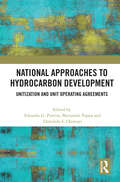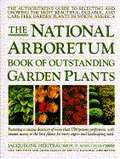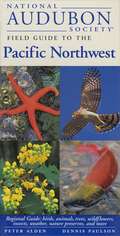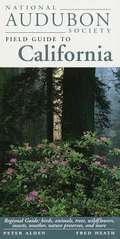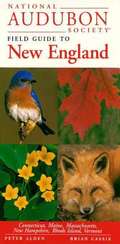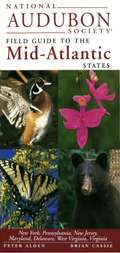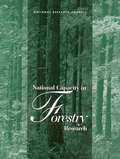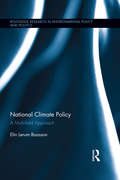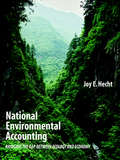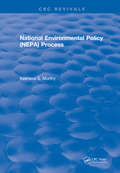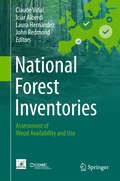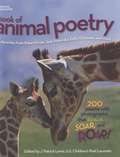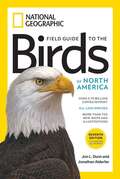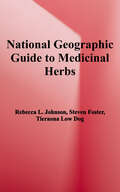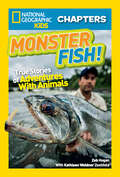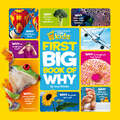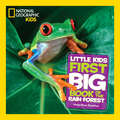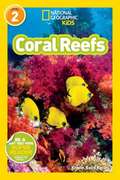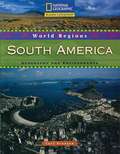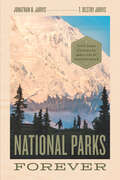- Table View
- List View
National Approaches to Hydrocarbon Development: Unitization and Unit Operating Agreements
by Damilola S. Olawuyi Eduardo G. Pereira Marianthi PappaThis book analyses the legal obstacles associated with the advancement of unitization processes and procedures at a national, domestic level.It uses case studies of identified jurisdictions with relevant States practice and unitization experience in terms of the domestic legal framework and practices. For experience in unitization, the book will focus on the following countries: the United States, Canada, the United Kingdom, Norway, Brazil, Mexico, Ghana and Nigeria. Focusing on best practices which have influenced the development of the unitization concept, the book looks at the formulation of different models and operating agreements, and their potential impact on unexplored hydrocarbon resources, particularly in cases where unitization is necessary.The book will be of interest to practitioners, scholars and students in the field of natural resource law, international law and unitization.
National Arboretum Book of Outstanding Garden Plants: The Authoritative Guide to Selecting and Growing the Most Beautiful, Durable, and Care-free Garden Plants in North America
by Jacqueline HeriteauThe guide book of the National Arboretum book for outstanding garden plants.
National Audubon Society Field Guide To The Pacific Northwest: Regional Guide: Birds, Animals, Trees, Wildflowers, Insects, Weather, Nature Pre Serves, And More (Audubon Society Regional Field Guides)
by National Audubon SocietyThe most comprehensive field guide available to the Pacific Northwest--a portable, essential companion for visitors and residents alike--from the go-to reference source for over 18 million nature lovers. This compact volume contains: An easy-to-use field guide for identifying 1,000 of the region's wildflowers, trees, mushrooms, mosses, fishes, amphibians, reptiles, birds, butterflies, mammals, and much more; A complete overview of the Pacific Northwest's natural history, covering geology, wildlife habitats, ecology, fossils, rocks and minerals, clouds and weather patterns and night sky; An extensive sampling of the area's best parks, preserves, beaches, forests, islands, and wildlife sanctuaries, with detailed descriptions and visitor information for 50 sites and notes on dozens of others. The guide is packed with visual information -- the 1,500 full-color images include more than 1,300 photographs, 14 maps, and 16 night-sky charts, as well as 150 drawings explaining everything from geological processes to the basic features of different plants and animals. For everyone who lives or spends time in Washington or Oregon, there can be no finer guide to the area's natural surroundings than the National Audubon Society Field Guide to the Pacific Northwest.
National Audubon Society Field Guide to the Pacific Northwest
by Peter Alden Dennis Paulson Amy Gregoret Daniel Mathews Richard Keen Eric A. Oches Robert Sundstrom Wendy B. ZomleferA complete overview of the Pacific Northwest's natural history, covering geology, wildlife habitats, ecology, fossils, rocks and minerals, clouds and weather patterns and night sky.
National Audubon Society Regional Guide To California (Audubon Society Regional Field Guides)
by Peter Alden National Audubon Society StaffFilled with concise descriptions and stunning photographs, the National Audubon Society Field Guide to California belongs in the home of every California resident and in the suitcase or backpack of every visitor. This compact volume contains: An easy-to-use field guide for identifying 1,000 of the state's wildflowers, trees, mushrooms, mosses, fishes, amphibians, reptiles, birds, butterflies, mammals, and much more; A complete overview of California's natural history, covering geology, wildlife habitats, ecology, fossils, rocks and minerals, clouds and weather patterns and night sky; An extensive sampling of the area's best parks, preserves, beaches, forests, islands, and wildlife sanctuaries, with detailed descriptions and visitor information for 50 sites and notes on dozens of others. The guide is packed with visual information -- the 1,500 full-color images include more than 1,300 photographs, 14 maps, and 16 night-sky charts, as well as 150 drawings explaining everything from geological processes to the basic features of different plants and animals. For everyone who lives or spends time in California, there can be no finer guide to the area's natural surroundings than the National Audubon Society Field Guide to California.
National Audubon Society Regional Guide To New England
by Peter Alden National Audubon Society StaffFilled with concise descriptions and stunning photographs, the National Audubon Society Field Guide to New England belongs in the home of every New England resident and in the suitcase or backpack of every visitor. This compact volume contains: An easy-to-use field guide for identifying 1,000 of the region's wildflowers, trees, mushrooms, mosses, fishes, amphibians, reptiles, birds, butterflies, mammals, and much more; A complete overview of New England's natural history, covering geology, wildlife habitats, ecology, fossils, rocks and minerals, clouds and weather patterns and night sky; An extensive sampling of the area's best parks, preserves, beaches, forests, islands, and wildlife sanctuaries, with detailed descriptions and visitor information for 50 sites and notes on dozens of others. The guide is packed with visual information -- the 1,500 full-color images include more than 1,300 photographs, 14 maps, and 16 night-sky charts, as well as 150 drawings explaining everything from geological processes to the basic features of different plants and animals. For everyone who lives or spends time in Connecticut, Maine, Massachusetts, Rhode Island, New Hampshire, or Vermont, there can be no finer guide to the area's natural surroundings than the National Audubon Society Field Guide to New England.
National Audubon Society Regional Guide to the Mid-Atlantic States
by Peter Alden Chanticleer Press Staff National Audubon Society Staff Chanticleer Press Inc. StaffFilled with concise descriptions and stunning photographs, the National Audubon Society Field Guide to the Mid-Atlantic States belongs in the home of every Mid-Atlantic resident and in the suitcase or backpack of every visitor This compact volume contains: An easy-to-use field guide for identifying 1,000 of the state's wildflowers, trees, mushrooms, mosses, fishes, amphibians, reptiles, birds, butterflies, mammals, and much more; A complete overview of the Mid-Atlantic region's natural history, covering geology, wildlife habitats, ecology, fossils, rocks and minerals, clouds and weather patterns, and the night sky; An extensive sampling of the area's best parks, preserves, beaches, forests, islands, and wildlife sanctuaries, with detailed descriptions and visitor information for 50 sites and notes on dozens of others. The guide is packed with visual information -- the 1,500 full-color images include more than 1,300 photographs, 18 maps, and 16 night-sky charts, as well as more than 100 drawings explaining everything from geological processes to the basic features of different plants and animals For everyone who lives or spends time in Delaware, Maryland, New Jersey, New York, Pennsylvania, Virginia, West Virginia, or Washington, D. C. , there can be no finer guide to the area's natural surroundings than the National Audubon Society Field Guide to the Mid-Atlantic States.
National Audubon Society® Field Guide to the Night Sky
by Wil Tirion Mark R. Chartrand National Audubon Society StaffThe perfect companion volume for Hale-Bopp watchers, this guide explores the fabulous mysteries above, from planets in our solar system to the constellations in both the Northern and Southern hemispheres, stars, galaxies (including the Milky Way), nebulae, astronomical bodies, objects, phenomena, and -- yes -- comets. Night Sky provides a concise guided tour of the heavens with 48 monthly sky charts of the northern sky and 88 constellation charts, each offering a detailed map of individual constellations. Essays on the universe, the solar system, and constellations introduce the reader to the wonders of the sky.
National Capacity in Forestry Research
by Committee on National Capacity in Forestry ResearchThe National Academies Press (NAP)--publisher for the National Academies--publishes more than 200 books a year offering the most authoritative views, definitive information, and groundbreaking recommendations on a wide range of topics in science, engineering, and health. Our books are unique in that they are authored by the nation's leading experts in every scientific field.
National Climate Policy: A Multi-field Approach (Routledge Research in Environmental Policy and Politics)
by Elin Lerum BoassonFailed attempts at producing ambitious global climate commitments and instruments have made it increasingly important for nation states to deliver climate policies. This in turn requires a better understanding of national climate policymaking. In this book, Elin Lerum Boasson develops an innovative and well-grounded analytical framework for assessing national climate-policy development. Why do national climate policies emerge and change? This question is underpinned by the role played by different actors and the kind social mechanism at work. Boasson asks, to what extent and how is the emergence and change of climate policy influenced by: politicians and the national political fields; business and organizational fields; EU policy and the European environment; social and entrepreneurial mechanisms? Combining policy studies with sociological new institutionalism, and drawing on three climate policy sub-areas in Norway: renewable energy, low-energy buildings and carbon capture and storage, Boasson presents a multi-field framework that allows the reader to capture the entire policy cycle, explaining policy initiation, policy adoption and the long-term, social feedback effects resulting from implementation (or lack of implementation).
National Environmental Accounting: Bridging the Gap between Ecology and Economy
by Joy E HechtThis book presents national environmental, or 'green' accounting as it has developed in Europe and other parts of the world. It introduces the most recent methods developed through the United Nations Statistical Department and other international organizations, but bridges the gap between the superficial treatment of environmental accounting in economics textbooks and environmental literature, on the one hand, and the highly technical manuals of international organizations, on the other. Joy Hecht begins with a history and introduction to national income accounting. The first part of her book explains how the environmental accounts build on the structure of the 1993 System of National Accounts. She then shows the UN approach to accounting applied to pollution, recycling, and the management of natural resources such as forests, minerals, and fisheries. The third section discusses how the accounts approach green GDP and other macroeconomic indicators. The book concludes by going beyond the UN structures to discuss other adjusted macroeconomic measures and how accounting data can be used to build them. National Environmental Accounting is a non-technical introduction to an increasingly important field. It is a must-read for anyone interested in how environmental accounts can help society move towards greater sustainability.
National Environmental Policy (NEPA) Process
by K.S. MurthyThis book is mainly about the National Environmental Policy Act (NEPA) of 1969 and the process for its implementation. This is most often called theNEPA process. The need for this book arises because, although the awareness for faithful implementation of NEPA has now matured, the method of NEPA implementation is not always known, and hence, needs to be clearly laid out for the benefit of project engineers and the decision makers in government and industry. This book aims to do that.
National Forest Inventories
by Claude Vidal Iciar A. Alberdi Laura Hernández Mateo John J. RedmondThe book presents the current state and good practices of national forest inventories in monitoring wood resources and demonstrates pathways for harmonisation and improved common reporting. Beyond a general overview over availability and use of wood resources in different countries, it provides a unique collection of original contributions from national forest inventory experts with in-depth descriptions of current NFI methods in assessing wood availability and wood use in European countries, and selected countries from America and Asia. The main topics are national definitions and improvements in common reporting of forests available for wood supply, stem quality and assortments, estimation of change including growth and drain, and tree resources outside forest land. The book is a must-have for everyone who is contributing to national forest inventories either methodologically or operatively, for people who want or need to understand national forest inventory provided data and information on the availability of wood resources. By providing profound knowledge it is a valuable basis for scientists involved in scenario modelling and analysing effects of climate change, as well as individuals in private organisations and public administrations promoting the sustainable use of natural resources and the potential of green economy.
National Geographic Book of Animal Poetry: 200 Poems With Photographs That Squeak, Soar, and Roar!
by J. Patrick LewisNamed one of the Best Children's Books of 2012 by Kirkus Reviews! Named one of the top Children's Books of 2012 by the New York Public Library! "Add a little natural wonder to your poetry shelves. Because if we're talking about the best possible compliment to your eyes and ears alike, few have as many perks and grand moments as this. " --School Library Journal starred review "Out of a windless August night/A luna moth in ghostly light Beat softly on my window screen/Tick-tick-ticking-all silver green. She whispered secrets in my ear--/I am but a stranger here. The stars are scrawled across the sky/By ghostwriters, the Moon and I. You will not see me here tonight--/I have a thousand stars to write. " What could be better than cuddling up with your child and this book on your lap and allowing your imaginations to soar with the words and images? Lovingly selected by U. S. Children's Poet Laureate J. Patrick Lewis and paired with vibrant animal photography, this collection of poems is an exuberant celebration of the animal kingdom and a beautiful introduction to this genre of literature. Designed for family sharing but targeted to ages 4-8, this dynamic, fresh, yet still classic collection of animal poems is a must-have for the family bookshelf. Featured poets include J. Patrick Lewis, Dorothy Aldis, Emily Dickinson, Benjamin Franklin, Robert Frost, Rudyard Kipling, Jack Prelutsky, Elizabeth Madox Roberts, Robert Louis Stevenson, Alfred, Lord Tennyson, and many more. Divided into chapters that group the poems by theme for extra resonance, the collection is a mix of old and new, classics, and never-before-published. A foreword from Lewis, sets the scene for helping children appreciate this gift of language and this visual feast for the eyes. Chapters include: Welcome to the World (birth of animal young) Big Ones (large animals--elephants, hippos, rhinos, bears) Little Ones (small animals--worms, insects) Winged Ones (birds and other flying creatures) Water Ones (aquatic animals--fish, dolphins, crabs) Strange Ones (curious creatures--armadillos, centipedes) Noisy Ones (loud animals--lions, hyenas) Quiet Ones (silent or still animals--hens, rabbits, snakes) Last Thought (a reflection on the world we share with animals)
National Geographic Field Guide To The Birds Of North America, 7th Edition
by Jonathan AlderferThis fully revised edition of the best-selling North American bird field guide is the most up-to-date guide on the market. Perfect for beginning to advanced birders, it is the only book organized to match the latest American Ornithological Society taxonomy. With more than 2.75 million copies in print, this perennial bestseller is the most frequently updated of all North American bird field guides. Filled with hand-painted illustrations from top nature artists (including the ever-popular hummingbird), this latest edition is poised to become an instant must-have for every serious birder in the United States and Canada. The 7th edition includes 37 new species for a total of 1,023 species; 16 new pages allow for 250 fresh illustrations; 80 new maps; and 350 map revisions. With taxonomy revised to reflect the radical new American Ornithological Society taxonomy established in 2016, the addition of standardized banding codes, and text completely vetted by birding experts, this new edition will top of the list of birding field guides for years to come.
National Geographic Guide to Medicinal Herbs: The World's Most Effective Healing Plants
by Steven Foster Rebecca L. Johnson Tieraona Low Dog"This excellent guide is the work of a team of highly qualified botanical and medical experts, including two of my colleagues from the Arizona Center for Integrative Medicine. It offers reliable, up-to-date, practical information about 72 of the most important medicinal herbs." --Andrew Weil, M.D., from the Foreword. There is a world of health and healing all around you--in your spice rack, your backyard, and on the shelves of health food and grocery stores. This informative guide is a reference you will keep at the ready, connecting 72 of the world's most common and useful medicinal herbs with the body systems they help and heal.Eight chapters focus on body systems:1. Mental Health & the Nervous System2. Respiratory System3. Heart & Circulation4. Digestive System5. Joints, Muscles & Skin6. Urinary & Male Health7. Female Health8. Wellness & PerceptionEach chapter begins with an overview of how plants can bring health to that part of the body, with stories about traditional herbal remedies from around the world and current scientific findings on herbal remedies for specific illnesses. Then each chapter highlights nine plants, combining botanical and medical information--therapeutic uses, effectiveness, preparations, cautions, and advice, including a round-up of current science about the active ingredients in the plant. Every chapter includes a photo gallery showing how one of its herbs is cultivated and processed commercially--the story behind the contents of that bottle you buy in the store. Special features include "Over the Kitchen Counter"--quick and easy ways to use herbs in your everyday life, and time lines for every herb, showing how today's use of herbal remedies collects wisdom from the centuries and around the world. A functional appendix includes an illustrated index to all the plants in the book, an ailment-by-ailment therapeutic index, a glossary, and an index.
National Geographic Kids Chapters: Adventure Cat! (NGK Chapters)
by Kathleen ZoehfeldJoin three fantastic felines as they embark on the adventures of their (nine) lives in this colorful Chapters book, filled with photos and fun facts.Meet Dusty, a Siamese cat who gives the phrase "cat burglar" new meaning. Take to the seas with Skatty, a sailor and cat hero. And trek across the United States with Vladimir, a real-life cat explorer! These amazing--and TRUE--stories are sure to keep cat lovers and adventure fans on the edge of their seats.
National Geographic Kids Chapters: True Stories of Adventures With Animals (NGK Chapters)
by Kathleen Weidner Zoehfeld Zeb HoganFor Zeb Hogan, bigger is better – especially when it comes to fish. From sawfish to alligator gars to giant stingrays, Zeb's on a mission to save the world's freshwater giants. In this cool Chapter book, you'll join Zeb on amazing – and TRUE – adventures with supersize swimmers.
National Geographic Kids Chapters: True Stories of Extreme Adventures! (NGK Chapters)
by Kitson JazynkaAccomplished outdoor explorer Gregg Treinish loves adventure! Whether it's spending two years hiking the remote and perilously high Andes Mountains or coming face to face with wolverines, lynx, and bears, Gregg always knows where the action is. With gripping—and totally true—stories of incredible adventures, extreme excursions, and ultimate survival, this book will have you on the edge of your seat.
National Geographic Little Kids First Big Book of Why (National Geographic Little Kids First Big Books)
by Amy ShieldsLinking to a popular feature in the super successful National Geographic Little Kids magazine, this book brings the browsable fun of the bestselling National Geographic Kids Almanac to a new audience: preschoolers! Using an interactive question-and-answer format and content grounded in a child's immediate world, the Big Book of Why delivers lively information, hands-on games, simple recipes, crafts, and more. What makes a car go? How does mushy dough become a crispy cookie? What does the doctor see in my throat? An essential parent reference, The Big Book of Why invites children to ask big questions, think big thoughts, and get answers that are accurate, engaging, level-appropriate, and based on sound educational findings. It helps prepare preschoolers for school in an interactive way—the very best way to foster learning at this age, according to research. Highly photographic and playful, this big book is an adventure in exploration.
National Geographic Little Kids First Big Book of the Rain Forest (National Geographic Little Kids First Big Books)
by Moira Rose DonohueColoful birds! Jaguars! Tree frogs! National Geographic presents a delightful, age-appropriate introduction to tropical rain forest creatures big and small in this new title in the popular Little Kids First Big Book series.This adorable animal book about all things jungle features favorite animals found in tropical rain forests. Readers meet jaguars prowling the forest floor, snakes slithering through the understory, red-eyed tree frogs leaping through the canopy, butterflies flitting through the tallest treetops, and many other creatures that inhabit all the different layers. More than 200 charming animal photos illustrate the profiles, with facts about the creatures' sizes, diets, homes, and more. A map of tropical rain forests around the world shows where the animals in the book are found, and the book also introduces readers to plant life. This book will quickly become a favorite at storytime, bedtime, and any time.
National Geographic Readers: Coral Reefs (Readers Series)
by Kristin RattiniIn this level 2 reader, young readers explore the amazing underwater world of coral reefs. Beautiful photos and carefully leveled text make this book perfect for reading aloud and for independent reading.
National Geographic Reading Expeditions World Regions: South America Geography and Environment
by Carl ProujanTake a look at the dramatically different environments in South America, the towering Andes, the grasslands, the Amazon rain forest, and the varied coastal areas. Examine how elevation and latitude affect the land and its vegetation and wildlife.
National Parks Forever: Fifty Years of Fighting and a Case for Independence
by Jonathan B. Jarvis T. Destry JarvisTwo leaders of the National Park Service provide a front-row seat to the disastrous impact of partisan politics over the past fifty years.The US National Parks, what environmentalist and historian Wallace Stegner called America’s “best idea,” are under siege. Since 1972, partisan political appointees in the Department of the Interior have offered two conflicting views of the National Park Service (NPS): one vision emphasizes preservation and science-based decision-making, and another prioritizes economic benefits and privatization. These politically driven shifts represent a pernicious, existential threat to the very future of our parks.For the past fifty years, brothers Jonathan B. and T. Destry Jarvis have worked both within and outside NPS as leaders and advocates. National Parks Forever interweaves their two voices to show how our parks must be protected from those who would open them to economic exploitation, while still allowing generations to explore and learn in them. Their history also details how Congress and administration appointees have used budget and staffing cuts to sabotage NPS’s ability to manage the parks and even threatened their existence. Drawing on their experience, Jarvis and Jarvis make a bold and compelling proposal: that it is time for NPS to be removed from the Department of the Interior and made an independent agency, similar to the Smithsonian Institution, giving NPS leaders the ability to manage park resources and plan our parks’ protection, priorities, and future.“Painful history plus a roadmap for change equals a compelling book.” ―Revelator“This book is compelling reading for all conservation biologists to emulate positive aspects and avoid pitfalls when developing an effective and self-sustaining park system.” ―Community Ecology
National Parks: The American Experience
by Alfred RunteThe National Parks: America's Best Idea," Alfred Runte is renowned as the nation's leading historian on the meaning and management of these treasured lands. Lavishly illustrated with period photographs, including eight pages of color paintings, National Parks: The American Experience has never been more beautiful or profound. This remains a stirring look into the lands that define America, from Yosemite and Yellowstone to wilderness Alaska.
